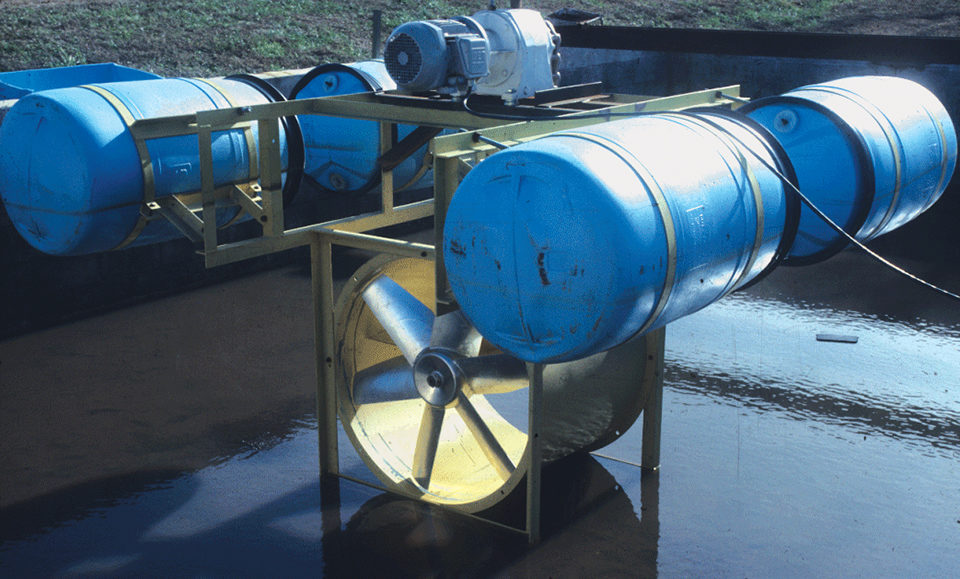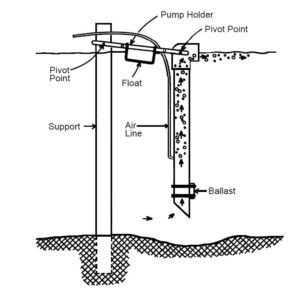Dense growths of macrophytic algae can be troublesome in freshwater ponds

Water circulation and mixing in aquaculture ponds have traditionally been mechanically induced by aeration equipment. Although designed to transfer oxygen to water, aerators also create strong water currents that cause circulation and mixing. Recently, some companies have begun selling equipment designed specifically to circulate pond water.
Uniform water quality
In still water, the water column stratifies thermally during the day when solar radiation causes the surface to heat faster than deeper layers. In aquaculture ponds – which are seldom over 2 meters deep – the upper layers of water cool by conduction at night, and the water column mixes. Nevertheless, during the daytime, dissolved-oxygen concentrations can be much lower near the pond bottom than near the surface.
Mixing by wind or mechanical devices can prevent stratification and provide more dissolved oxygen near the pond bottom. Ponds with good water circulation across their bottoms are much less likely to have anaerobic conditions at the sediment-water interface than ponds with less circulation.
Dissolved oxygen production by photosynthesis is intense under well-illuminated conditions, so the surface waters of ponds usually are supersaturated with dissolved oxygen during the day. Mechanical aerators do not transfer oxygen to water that is saturated with dissolved oxygen, but aerators that splash water increase the loss of oxygen to the air from supersaturated water. Mechanical circulation that does not splash water blends the surface water with deeper water and conserves dissolved oxygen from photosynthesis.
Mixing and circulation provide a more uniform environment for aquaculture in which water temperature and concentrations of dissolved gases and nutrients tend to be similar throughout. This prevents localized zones with impaired water quality.
Algae control
Illumination decreases with depth. Photosynthesis by phytoplankton at depths below 50 cm can be light-limited. In a mixed pond, planktonic algae are transported continually throughout the water column by the circulating water. As a result, the exposure of phytoplankton to light tends to be more uniform in a well-mixed pond than in a still pond. There is evidence that circulation stimulates dissolved-oxygen production by phytoplankton in ponds, because on average, algal cells receive more exposure to light.
Blue-green algae often accumulate on the surfaces of ponds as scum. These scums favor shallow thermal stratification and may be killed by bright light near the surface. Massive die-offs of blue-green algae can cause low dissolved oxygen and other water quality problems.
Circulation is beneficial in reducing the tendency for algal scums. Dense growths of macrophytic algae such as Spirogyra, Hydrodictyon and Rhizoclonium also can be troublesome in freshwater ponds. Strong water mixing can prevent the growth of these algae or at least accumulations of algal masses in certain areas of ponds.
Mechanical circulators
Mechanical aerators provide strong water circulation. However, their effectiveness in transferring oxygen during daytime is limited, and they are much more efficient during the night. Some experts feel that a combination of mechanical water circulation during the day and mechanical aeration at night might be the most effective way to manage dissolved-oxygen concentrations in ponds.
Conserving dissolved oxygen from photosynthesis by blending the surface water with deeper water in the daytime should lessen the amount of mechanical aeration required at night. Several types of mechanical water circulators have been developed for use in aquaculture, but two types have the greatest potential.

Air-lift pumps
The most well-known circulation device is the air-lift pump. These pumps are constructed of a length of PVC pipe, termed the eductor, and a PVC elbow. Air from a low-pressure, high-volume blower is released through a right-angle hose adaptor into the PVC pipe. Alternatively, air may be released through a diffuser to produce smaller bubbles.
Rising air bubbles lift water through the eductor and discharge it at the surface. A pump holder with flotation device is attached between the anchor post and pump to allow the pump to pivot in response to changes in water depth. Ballast must be provided at the bottom of the pump.
Many variations in the designs of air-lift devices have been used, and equations have been developed for predicting their discharge. The pumps create water circulation by lifting water from near the bottom and releasing it at the surface. Air-lift pumps also cause some aeration, because oxygen in the rising air bubbles diffuses into the water. Increased turbulence caused by the pump discharge onto the water surface also increases oxygenation slightly.
Usually the energy expenditure for oxygen transfer is three to five times greater for air lifts than standard mechanical aerators. Thus, air-lift pumps should not be thought of as aerators, but as water circulators. Air lifts have been used in ponds, but because of their relatively small size, they are best suited for small, intensive production units and hatchery tanks.
Horizontal circulators
Horizontal, axial-flow water circulators are more suitable for use in ponds because they discharge much more water than air lifts. Designed at Auburn University, a water circulator powered by a 3-hp gear motor that incorporated 76-cm-diameter fan blades mounted within a 92-cm-diameter, 111-cm-long housing was capable of discharging about 60 cubic meters per minute when operated at 90 rpm. Several companies have manufactured modified versions of this design.
Simpler water circulators have been made by attaching a large propeller to the output shaft of a submersible motor. Propeller-type circulators do not have housings, but deliver discharge:horsepower ratios similar to the large device described above.
Horizontal-discharge water circulators are not designed to effect aeration. Nevertheless, they increase turbulence at the water surface, which can slightly increase gas transfer between air and water.
Circulation studies
Several studies of water circulation were conducted in the late 1980s and early 1990s with similar results. For example, a water circulator of the type built at Auburn University was evaluated by C.S. Tucker and J.A. Steeby in channel catfish ponds in Mississippi, USA. The water circulators were operated for six to eight hours during summer days.
Relative to ponds without circulators, midday water temperatures and dissolved-oxygen concentrations varied little with depth in ponds with circulators. Circulation did not reduce the incidence of critically low nighttime dissolved-oxygen concentrations, but did reduce the total hours of aeration required to support fish production by a factor of 0.58. The savings in power costs for aeration in the circulated ponds were largely offset by the costs of circulator operation.
In spite of the lack of convincing evidence of the benefits of water circulators, energy costs are rising worldwide, and the possibility for using mechanical water circulators to lessen the requirements for mechanical aeration appears worthy of a second round of scientific investigation and farm trials.
(Editor’s Note: This article was originally published in the July/August 2006 print edition of the Global Aquaculture Advocate.)
Now that you've finished reading the article ...
… we hope you’ll consider supporting our mission to document the evolution of the global aquaculture industry and share our vast network of contributors’ expansive knowledge every week.
By becoming a Global Seafood Alliance member, you’re ensuring that all of the pre-competitive work we do through member benefits, resources and events can continue. Individual membership costs just $50 a year. GSA individual and corporate members receive complimentary access to a series of GOAL virtual events beginning in April. Join now.
Not a GSA member? Join us.
Author
-

Claude E. Boyd, Ph.D.
Department of Fisheries and Allied Aquacultures
Auburn University
Alabama 36849 USA
Tagged With
Related Posts

Responsibility
A look at various intensive shrimp farming systems in Asia
The impact of diseases led some Asian shrimp farming countries to develop biofloc and recirculation aquaculture system (RAS) production technologies. Treating incoming water for culture operations and wastewater treatment are biosecurity measures for disease prevention and control.

Health & Welfare
A study of Zoea-2 Syndrome in hatcheries in India, part 3
In this third and final part, authors present recommendations to help reduce the incidence of Zoea-2 Syndrome, which is not caused by any known infectious agents in P. vannamei hatcheries in India.

Responsibility
Advances in super-intensive, zero-exchange shrimp raceways
Research at the Texas AgriLife Research Mariculture Laboratory is investigating ways to improve the economic viability of super-intensive raceways for shrimp production.

Responsibility
Airlifts combine pumping, water treatment in recirculation systems
Using the buoyancy of the entrained air bubbles to lift the water, airlifts are more energy-efficient and provide more aeration, carbon dioxide removal and foam fractionation for dissolved solids removal than centrifugal pump systems.

